Showing Spotlights 209 - 216 of 315 in category All (newest first):
 Synthesized carbon nanotubes, especially single-walled carbon nanotubes (SWCNTs), are in the form of bundles with other impurities such as catalyst particles and amorphous carbon debris. In order to be useful for many types of applications, for instance in nanoelectronic devices or biomedical applications, SWCNTs need to be purified and dispersed into individual nanotubes. One method to do this is by surfactant stabilization of the hydrophobic nanotube surface, which overcomes the van der Waals forces among the nanotubes and results in suspensions of individual SWCNTs. Researchers have now investigated the cytotoxicity of SWCNTs suspended in various surfactants. Their experimental results show that the conjugates SDS/CNT and SDBS/CNT are toxic to astrocytoma cells due solely to the toxicity of the SDS and SDBS molecules, which administered alone are toxic to the cells even at a low concentration of 0.05 mg per ml within 30 min. However, the proliferation and viability of the astrocytoma cells were not affected by SWCNTs and the conjugates SC/CNT and DNA/CNT.
Synthesized carbon nanotubes, especially single-walled carbon nanotubes (SWCNTs), are in the form of bundles with other impurities such as catalyst particles and amorphous carbon debris. In order to be useful for many types of applications, for instance in nanoelectronic devices or biomedical applications, SWCNTs need to be purified and dispersed into individual nanotubes. One method to do this is by surfactant stabilization of the hydrophobic nanotube surface, which overcomes the van der Waals forces among the nanotubes and results in suspensions of individual SWCNTs. Researchers have now investigated the cytotoxicity of SWCNTs suspended in various surfactants. Their experimental results show that the conjugates SDS/CNT and SDBS/CNT are toxic to astrocytoma cells due solely to the toxicity of the SDS and SDBS molecules, which administered alone are toxic to the cells even at a low concentration of 0.05 mg per ml within 30 min. However, the proliferation and viability of the astrocytoma cells were not affected by SWCNTs and the conjugates SC/CNT and DNA/CNT.
May 19th, 2008
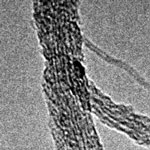 For a decade, researchers and industry professionals have been warning that the limits of silicon were quickly being approached. According to some, these limits have, effectively, already been reached. The age of the integrated microchip circuit - fabricated out of silicon - may be drawing to a close. But, is there any technology ready to fill the void? Is there any technology that could make circuits smaller or more powerful? They answer to this may very well be 'yes.' Although silicon holds numerous properties that make it a rather ideal conductor of electricity under certain conditions, it lacks one crucial characteristic, which may end-up making carbon the material of the future: The ability to form complex, tubular arrays on the scale of only a few nanometers. The age of the integrated nanochip circuit - made-up of composite carbon nanotubes - may have arrived.
For a decade, researchers and industry professionals have been warning that the limits of silicon were quickly being approached. According to some, these limits have, effectively, already been reached. The age of the integrated microchip circuit - fabricated out of silicon - may be drawing to a close. But, is there any technology ready to fill the void? Is there any technology that could make circuits smaller or more powerful? They answer to this may very well be 'yes.' Although silicon holds numerous properties that make it a rather ideal conductor of electricity under certain conditions, it lacks one crucial characteristic, which may end-up making carbon the material of the future: The ability to form complex, tubular arrays on the scale of only a few nanometers. The age of the integrated nanochip circuit - made-up of composite carbon nanotubes - may have arrived.
May 14th, 2008
 Fuel cells have gained a lot of attention because they provide a potential solution to our addiction to fossil fuels. Energy production from oil, coal and gas is an extremely polluting, not to mention wasteful, process that consists of heat extraction from fuel by burning it, conversion of that heat to mechanical energy, and transformation of that mechanical energy into electrical energy. In contrast, fuel cells are electrochemical devices that convert a fuel's chemical energy directly to electrical energy with high efficiency and without combustion (although fuel cells operate similar to batteries, an important difference is that batteries store energy, while fuel cells can produce electricity continuously as long as fuel and air are supplied). Modern fuel cells have the potential to revolutionize transportation. One of the leading fuel cell technologies developed in particular for transportation applications is the proton exchange membrane fuel cell, also known as polymer electrolyte membrane fuel cells - both resulting in the same acronym PEMFC
Fuel cells have gained a lot of attention because they provide a potential solution to our addiction to fossil fuels. Energy production from oil, coal and gas is an extremely polluting, not to mention wasteful, process that consists of heat extraction from fuel by burning it, conversion of that heat to mechanical energy, and transformation of that mechanical energy into electrical energy. In contrast, fuel cells are electrochemical devices that convert a fuel's chemical energy directly to electrical energy with high efficiency and without combustion (although fuel cells operate similar to batteries, an important difference is that batteries store energy, while fuel cells can produce electricity continuously as long as fuel and air are supplied). Modern fuel cells have the potential to revolutionize transportation. One of the leading fuel cell technologies developed in particular for transportation applications is the proton exchange membrane fuel cell, also known as polymer electrolyte membrane fuel cells - both resulting in the same acronym PEMFC
May 13th, 2008
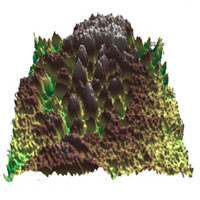 With the advance of nanotechnologies the demand for ever more precise instruments that measure, map and manipulate details at the nanoscale increases as well. For instance, the study of potential distributions with nanoscale resolution becomes increasingly important. In the early days of atomic force microscopy (AFM) the scanning force microscope was used to measure charges, dielectric constants, film thickness of insulating layers, photovoltage, and electrical potential of a given surface. Then, in 1991, the concept of a scanning contact potential microscope was introduced, allowing the simultaneous measurement of topography and contact potential difference. Named the scanning surface potential microscope (SSPM) - also often referred to as Kelvin probe force microscope - this is a variation of the AFM that measures the electrostatic forces (potential) between the probe tip and the surface of a material. Compared with other AFM techniques, the lateral resolution of traditional SSPM, from submicron down to 10 nm, is much lower.
With the advance of nanotechnologies the demand for ever more precise instruments that measure, map and manipulate details at the nanoscale increases as well. For instance, the study of potential distributions with nanoscale resolution becomes increasingly important. In the early days of atomic force microscopy (AFM) the scanning force microscope was used to measure charges, dielectric constants, film thickness of insulating layers, photovoltage, and electrical potential of a given surface. Then, in 1991, the concept of a scanning contact potential microscope was introduced, allowing the simultaneous measurement of topography and contact potential difference. Named the scanning surface potential microscope (SSPM) - also often referred to as Kelvin probe force microscope - this is a variation of the AFM that measures the electrostatic forces (potential) between the probe tip and the surface of a material. Compared with other AFM techniques, the lateral resolution of traditional SSPM, from submicron down to 10 nm, is much lower.
May 12th, 2008
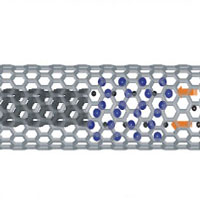 As far as test tubes go, it doesn't get any smaller than a single-walled carbon nanotube (SWCNT). Among the wide range of interesting properties exhibited by SWCNTs is their capacity to encapsulate molecules within their quasi one-dimensional cavity. The confinement offered by the nanotube could serve as a nanoscale test tube to constrain a chemical reaction. This was demonstrated in principle back in 1998, when the coalescence of adjacent fullerenes was observed by transmission electron microscopy. In the following years, scientists have extensively experimented with filling nanotubes with other fullerenes, atoms, molecules and, very recently, with organic molecules. Owing to their large variety with diverse chemical properties, the incorporated organic molecules can tune the properties of the SWCNTs. Scientists are intrigued by the possibilities that SWCNTs' use as a reaction tube offers for chemistry at the nanoscale. Nanochemistry - a key to control self-assembly processes prerequisite for nanotechnology - in essence would produce stable chemical reactions inside a confined nanoscale space. Encapsulated inside this nanoscale space, molecules are isolated from the outside environment, which allows one to identify and control the source and incidence of chemical reactions. Recent work has demonstrated this new chemistry by using SWCNTs as a nanometer-scale reaction furnace.
As far as test tubes go, it doesn't get any smaller than a single-walled carbon nanotube (SWCNT). Among the wide range of interesting properties exhibited by SWCNTs is their capacity to encapsulate molecules within their quasi one-dimensional cavity. The confinement offered by the nanotube could serve as a nanoscale test tube to constrain a chemical reaction. This was demonstrated in principle back in 1998, when the coalescence of adjacent fullerenes was observed by transmission electron microscopy. In the following years, scientists have extensively experimented with filling nanotubes with other fullerenes, atoms, molecules and, very recently, with organic molecules. Owing to their large variety with diverse chemical properties, the incorporated organic molecules can tune the properties of the SWCNTs. Scientists are intrigued by the possibilities that SWCNTs' use as a reaction tube offers for chemistry at the nanoscale. Nanochemistry - a key to control self-assembly processes prerequisite for nanotechnology - in essence would produce stable chemical reactions inside a confined nanoscale space. Encapsulated inside this nanoscale space, molecules are isolated from the outside environment, which allows one to identify and control the source and incidence of chemical reactions. Recent work has demonstrated this new chemistry by using SWCNTs as a nanometer-scale reaction furnace.
May 9th, 2008
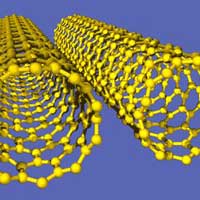 Sophisticated molecular-size motors have evolved in nature, where they are used in virtually every important biological process. In contrast, the development of synthetic nanomotors that mimic the function of these amazing natural systems and could be used in man-made nanodevices is in its infancy. Building nanoscale motors is not just an exercise in scaling down the design of a macroworld engine to nanoscale dimensions. Many factors such as friction, heat dissipation and many other mechanical behaviors are just very different at this scale - everything is constantly moving (under kinetic energy supplied by the heat of the surroundings) and being buffeted by other atoms and molecules (Brownian motion). In nature, biological motors use catalytic reactions to create forces based on chemical changes. These motors do not require external energy sources such as electric or magnetic fields. Instead, the input energy is supplied locally and chemically. Despite impressive progress over the past years, man-made nanomachines lack the efficiency and speed of their biological counterparts. New research has demonstrated that the incorporation of carbon nanotubes (CNT) into the platinum component of asymmetric metal nanowire motors leads to dramatically accelerated movement in hydrogen peroxide solutions, with average speeds of 50-60 micrometers per second.
Sophisticated molecular-size motors have evolved in nature, where they are used in virtually every important biological process. In contrast, the development of synthetic nanomotors that mimic the function of these amazing natural systems and could be used in man-made nanodevices is in its infancy. Building nanoscale motors is not just an exercise in scaling down the design of a macroworld engine to nanoscale dimensions. Many factors such as friction, heat dissipation and many other mechanical behaviors are just very different at this scale - everything is constantly moving (under kinetic energy supplied by the heat of the surroundings) and being buffeted by other atoms and molecules (Brownian motion). In nature, biological motors use catalytic reactions to create forces based on chemical changes. These motors do not require external energy sources such as electric or magnetic fields. Instead, the input energy is supplied locally and chemically. Despite impressive progress over the past years, man-made nanomachines lack the efficiency and speed of their biological counterparts. New research has demonstrated that the incorporation of carbon nanotubes (CNT) into the platinum component of asymmetric metal nanowire motors leads to dramatically accelerated movement in hydrogen peroxide solutions, with average speeds of 50-60 micrometers per second.
May 1st, 2008
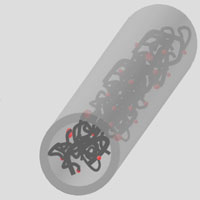 The race is on to develop the next generation of nanotechnology-enabled electrochemical energy storage devices, also knows as batteries. Lithium of course has long been recognized as an ideal material for energy storage due to its light weight and high electrochemical energy potential, as witnessed by the ubiquitous use of Li-ion batteries. There still seems to be considerable potential to further improve the performance characteristics of these Li-ion batteries. There have been many design approaches to creating lithium ion batteries but they usually share common features: The positive electrode is typically a lithium metal oxide, with various metals used such as cobalt, nickel, and manganese. The negative electrode is typically a carbon compound or natural or synthetic graphite. Researchers in Germany have now demonstrated a simple route for transforming cheap commercial carbon nanotubes into highly efficient carbon for electrochemical energy storage applications. When tested as electrode materials for lithium batteries, this composite material exhibits excellent performance over long test cycles.
The race is on to develop the next generation of nanotechnology-enabled electrochemical energy storage devices, also knows as batteries. Lithium of course has long been recognized as an ideal material for energy storage due to its light weight and high electrochemical energy potential, as witnessed by the ubiquitous use of Li-ion batteries. There still seems to be considerable potential to further improve the performance characteristics of these Li-ion batteries. There have been many design approaches to creating lithium ion batteries but they usually share common features: The positive electrode is typically a lithium metal oxide, with various metals used such as cobalt, nickel, and manganese. The negative electrode is typically a carbon compound or natural or synthetic graphite. Researchers in Germany have now demonstrated a simple route for transforming cheap commercial carbon nanotubes into highly efficient carbon for electrochemical energy storage applications. When tested as electrode materials for lithium batteries, this composite material exhibits excellent performance over long test cycles.
Apr 29th, 2008
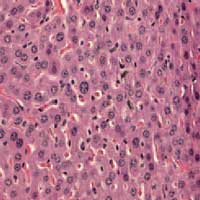 The toxicity issues surrounding carbon nanotubes (CNTs) are highly relevant for two reasons: Firstly, as more and more products containing CNTs come to market, there is a chance that free CNTs get released during their life cycles, most likely during production or disposal, and find their way through the environment into the body. Secondly, and much more pertinent with regard to potential health risks, is the use of CNTs in biological and medical settings. CNTs interesting structural, chemical, electrical, and optical properties are explored by numerous research groups around the world with the goal of drastically improving performance and efficacy of biological detection, imaging, and therapy applications. In many of these envisaged applications, CNTs would be deliberately injected or implanted in the body. For instance, CNT-based intercellular molecular delivery vehicles have been developed for intracellular gene and drug delivery in vitro. What these CNTs do once inside the body and after they discharge their medical payloads is not well understood. Cell culture studies have shown evidence of cytotoxicity and oxidative stress induced by single-walled carbon nanotubes (SWCNTs), depending on whether and to what degree they are functionalized or oxidized. A new study at Stanford University tested non-covalently pegylated SWCNTs as a 'least toxic scenario', and oxidized, covalently functionalized nanotubes as a 'most toxic scenario' in a study on mice. It was found that SWCNTs injected intravenously into nude mice do not appear to have any significant toxicity during an observation period of four months following injection.
The toxicity issues surrounding carbon nanotubes (CNTs) are highly relevant for two reasons: Firstly, as more and more products containing CNTs come to market, there is a chance that free CNTs get released during their life cycles, most likely during production or disposal, and find their way through the environment into the body. Secondly, and much more pertinent with regard to potential health risks, is the use of CNTs in biological and medical settings. CNTs interesting structural, chemical, electrical, and optical properties are explored by numerous research groups around the world with the goal of drastically improving performance and efficacy of biological detection, imaging, and therapy applications. In many of these envisaged applications, CNTs would be deliberately injected or implanted in the body. For instance, CNT-based intercellular molecular delivery vehicles have been developed for intracellular gene and drug delivery in vitro. What these CNTs do once inside the body and after they discharge their medical payloads is not well understood. Cell culture studies have shown evidence of cytotoxicity and oxidative stress induced by single-walled carbon nanotubes (SWCNTs), depending on whether and to what degree they are functionalized or oxidized. A new study at Stanford University tested non-covalently pegylated SWCNTs as a 'least toxic scenario', and oxidized, covalently functionalized nanotubes as a 'most toxic scenario' in a study on mice. It was found that SWCNTs injected intravenously into nude mice do not appear to have any significant toxicity during an observation period of four months following injection.
Apr 22nd, 2008
 Synthesized carbon nanotubes, especially single-walled carbon nanotubes (SWCNTs), are in the form of bundles with other impurities such as catalyst particles and amorphous carbon debris. In order to be useful for many types of applications, for instance in nanoelectronic devices or biomedical applications, SWCNTs need to be purified and dispersed into individual nanotubes. One method to do this is by surfactant stabilization of the hydrophobic nanotube surface, which overcomes the van der Waals forces among the nanotubes and results in suspensions of individual SWCNTs. Researchers have now investigated the cytotoxicity of SWCNTs suspended in various surfactants. Their experimental results show that the conjugates SDS/CNT and SDBS/CNT are toxic to astrocytoma cells due solely to the toxicity of the SDS and SDBS molecules, which administered alone are toxic to the cells even at a low concentration of 0.05 mg per ml within 30 min. However, the proliferation and viability of the astrocytoma cells were not affected by SWCNTs and the conjugates SC/CNT and DNA/CNT.
Synthesized carbon nanotubes, especially single-walled carbon nanotubes (SWCNTs), are in the form of bundles with other impurities such as catalyst particles and amorphous carbon debris. In order to be useful for many types of applications, for instance in nanoelectronic devices or biomedical applications, SWCNTs need to be purified and dispersed into individual nanotubes. One method to do this is by surfactant stabilization of the hydrophobic nanotube surface, which overcomes the van der Waals forces among the nanotubes and results in suspensions of individual SWCNTs. Researchers have now investigated the cytotoxicity of SWCNTs suspended in various surfactants. Their experimental results show that the conjugates SDS/CNT and SDBS/CNT are toxic to astrocytoma cells due solely to the toxicity of the SDS and SDBS molecules, which administered alone are toxic to the cells even at a low concentration of 0.05 mg per ml within 30 min. However, the proliferation and viability of the astrocytoma cells were not affected by SWCNTs and the conjugates SC/CNT and DNA/CNT.
 Subscribe to our Nanotechnology Spotlight feed
Subscribe to our Nanotechnology Spotlight feed





